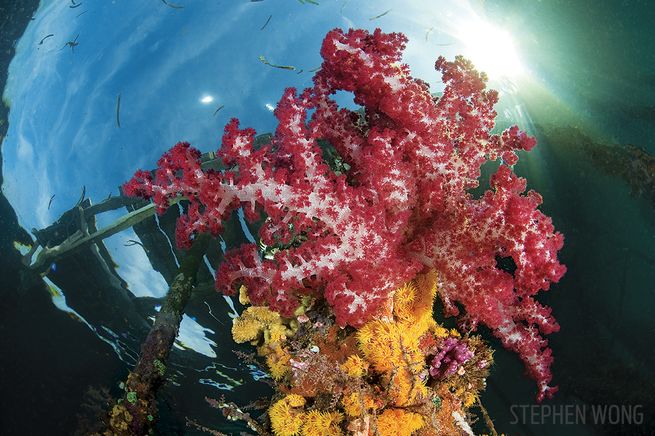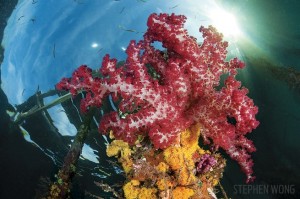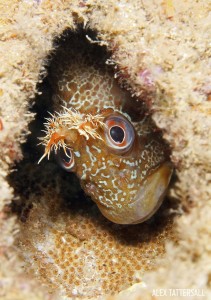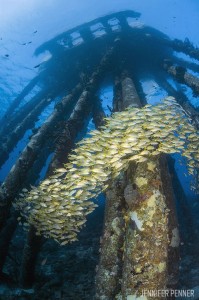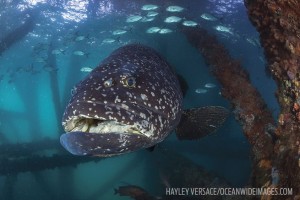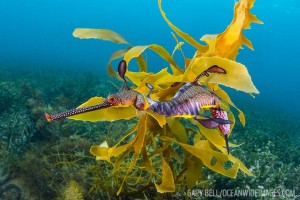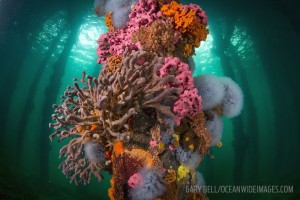1. Arborek Jetty, Indonesia
You don’t need to be a photographer or even a muck lover to appreciate Arborek Jetty off West Papua, Indonesia, part of the famed Raja Ampat archipelago. Look to blue water for passing manta rays, plus schools of sweetlip fish so numerous they blot out the sun.
If you’re willing to turn an eye to the muck and rubble, rewards range from a blue-ringed octopus to a Lembeh seadragon. Cast your gaze tighter to the macro realm to possibly encounter candy crabs, hairy shrimp, skeleton shrimp and a host of other odd critters.
Really, you don’t even need to dive at all to be entertained at this local village hangout. Kids jump and somersault from the pier, mugging for cameras and generally creating their own show just for laughs.
2. Swanage Pier, England
This pier is iconic in England, visited as much by topside travelers keen to take in views of the nearby Ballard Cliffs as by divers.
“People come just to tick the box of diving Swanage,” says Leon Butler, PADI IDC staff instructor and owner of Coast 2 Coast Scuba Diving, an outfitter located in the town of Poole, roughly an hour by car from the pier. But beyond just bragging rights, the site is overrun by wildlife, including common cuttlefish that measure roughly 20 inches long and thornback and undulate rays, velvet swimming crabs, sand eels, common lobsters, Ballan wrasse and corkwing wrasse.
Adds Butler, “There’s a reason this dive is so talked about.”
3. Salt Pier, Bonaire
Much of underwater Bonaire is relatively flat and gently sloping downward — making Salt Pier quite the contrast in terms of relief. With a rising vertical structure and an overhead environment, the pier acts as an oasis, sheltering more schools of fish than any other site in that depth range.
“Horse-eye jacks, grunts, mahogany snapper, angelfish — you see all kinds of schooling fish,” says Danny Hattink, scuba instructor for Buddy Dive Resort, a scuba diving operator on the Dutch island.
Also common are turtles in the shallows, as well as eagle rays passing through. “Plus, when the light falls through the beams,” says Hattink, “it’s just magical.”
4. Gavutu Wharf, Solomon Islands
Sunken aircraft, military supplies and other wreckage surviving the fierce World War II battle between the United States and Japan has long since become habitat for a wealth of macro and muck oddities at this South Pacific pier dive.
“You’ll find three-quarters of a Hellcat airplane covered in seven varieties of anemonefish,” says Shannon Kozak, of Solomon Islands Dive Expeditions, operator of the M/V Taka liveaboard, which regularly visits Gavutu Wharf.
Also littering the gentle sandy slope are a telephone, washing machine and tin cans, all dating from the war.
“Inside the washing machine, you’ll find anything from a bunch of sea cucumbers feeding to three types of nudibranchs to juvenile sweetlip fish,” says Kozak.
Granted, not everyone appreciates picking through what could be considered mere trash.
Says Kozak, “I really love it because it’s a treasure hunt. You get amazing history and a massive variety of marine life — it’s the best of both worlds.”
5. Exmouth Navy Pier, Western Australia
Because there are no pier dives along the Great Barrier Reef, head to the Exmouth Navy Pier, found on the coast opposite the Coral Sea — the western side of Australia. Because this dive lies along the same latitude as the midpoint of the Great Barrier Reef, it hosts a similar variety of tropical fauna. Here, wobbegong sharks — spotted like leopards, with a fringing beard — rest on the bottom alongside whitetip reef sharks, octopuses, stargazers and scorpionfish. And unlike the Great Barrier Reef, here the wildlife stays centralized, collecting under the overhead environment created by the 1,000-foot pier. As schooling trevally and estuarine cod swim past, you need to do nothing more than kneel in the sand.
6. Flinders Pier, Victoria, Australia
The weedy seadragon, endemic to southern Australia, is the main draw of this dive site 75 minutes by car south of Melbourne, the lively capital city of the state of Victoria on Australia’s southeastern corner.
Perhaps most surprising, this animal is big, at nearly a foot long — but it can still be difficult to spot against the kelp and seaweed it’s evolved to blend in with. One tip: The weedy sea- dragon’s range is typically just 90 square feet, and it prefers depths of 10 to 50 feet, perfect for this site that bot- toms out at just 22 feet and abounds with sea grass. But if that all sounds complicated, yes, guides are for hire.
7. Newport Pier, California
This is classic California pier diving at its best. Sea lions are as common at this Newport Beach landmark as kelp along the coast, and at 1,032 feet long, this pier is one where you won’t worry about running out of real estate.
The pylons here are many. They’re big, close together and covered in crabs and sea stars.
Says DJ Mansfield, director of operations for Beach Cities Scuba in town, “What’s really cool is to dive it straight down the middle to get that feeling of swimming down a hallway.”
8. Frederiksted Pier, St. Croix, U.S. Virgin Islands
You likely will find at least one seahorse on this beloved pier dive on the west side of St. Croix, the largest of the U.S. Virgin Islands. But it’s not just seahorses that make this dive worth wet-suiting up for. The site includes remains of an older pier as well as a newer one. Pilings in both sections are covered in orange coral- limorphs, yellow finger sponges, red encrusting sponges and the like, making it attractive to frogfish and more.
Kiersten Fidao, instructor with N2theBlue Scuba Diving, says the staff regularly finds new things. “Lately, we found squat lobsters, which we had to look up in the ID books, and an octopus that had laid eggs in the bottom of a can. It’s an awesome dive — which is why a lot of us dive it every day on the clock, and then after work just for fun.
10. Edithburgh Jetty, South Australia
If you’re already in Australia, hunting weedies, then stay and scout for leafy seadragons at the Edithburgh Jetty, two hours from the city of Adelaide. Leafy seadragons are the official marine emblem of South Australia. These seahorse relatives look like they’re in bloom; leaflike sprouts cover their bodies. Like those on weedies, these protrusions help the animal to camouflage itself. Bring a second tank for ample bottom time, as the site’s Port Jackson sharks — a 5-foot variety with a ridged forehead — and pajama squid, aka a striped species of bobtail squid — are curiosities in their own right worth lingering over.
Source: Sport Diver







